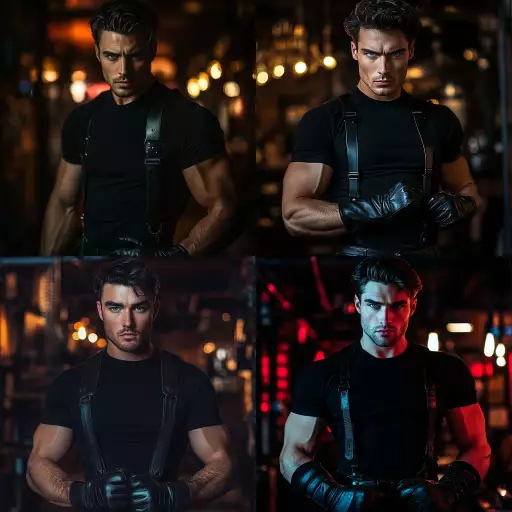Explore the Best AI Image Gallery

Pixels on Skin: AI-Generated Images and the Art Worlds Evolution
The realm of artistic creation is undergoing a seismic shift, powered by the rapid advancements in artificial intelligence (AI). AI-generated images, once a futuristic concept, are now becoming a tangible reality, blurring the lines between human creativity and machine ingenuity. This evolution presents both exhilarating opportunities and profound ethical considerations that demand careful examination.
The Birth of a New Medium
AI image generators, fueled by complex algorithms and vast datasets, can produce stunningly realistic and imaginative visuals at an unprecedented scale. These tools empower artists with new possibilities:
- Concept Exploration: Artists can rapidly iterate through various visual concepts, experimenting with different styles, compositions, and aesthetics to refine their ideas.
- Overcoming Technical Limitations: AI can assist in executing intricate details or complex compositions that may be challenging for human artists to achieve manually.
- Expanding Creative Boundaries: Artists can explore uncharted territories of artistic expression, pushing the boundaries of imagination by collaborating with AI to generate surreal, abstract, or entirely novel imagery.
The Ethical Labyrinth
While the creative potential of AI-generated images is undeniable, several ethical dilemmas arise:
- Authorship and Ownership: Who owns the copyright to an image created by an AI? Is it the programmer who developed the algorithm, the user who provides the input prompts, or the AI itself?
- Bias and Representation: AI models are trained on existing datasets, which may contain inherent biases that perpetuate stereotypes or underrepresent certain cultures and perspectives. This raises concerns about the potential for AI-generated imagery to reinforce societal inequalities.
- The Value of Human Creativity: Will the increasing accessibility of AI image generation diminish the perceived value of human artistry? How will artists navigate this evolving landscape to maintain their unique creative voices?
Navigating the Future Landscape
The integration of AI into the art world is an ongoing process, and its trajectory will be shaped by numerous factors:
- Technological Advancements:** Continued research and development in AI algorithms will undoubtedly lead to more sophisticated and versatile image generation capabilities.
- Legal and Policy Frameworks: Clear legal guidelines regarding copyright, ownership, and ethical use of AI-generated images are essential for fostering responsible innovation.
- Artistic Exploration and Adaptation:** Artists will continue to experiment with AI tools, finding innovative ways to incorporate them into their creative processes and push the boundaries of artistic expression.
Ultimately, the future of art in an age of AI depends on a collaborative approach that embraces both the transformative potential and the ethical complexities of this technology. By fostering open dialogue, responsible development, and a commitment to the value of human creativity, we can navigate this evolving landscape and unlock the full spectrum of artistic possibilities.
A New Renaissance
AI-generated images are not simply replacing traditional art; they are catalyzing a new era of artistic exploration. The fusion of human imagination with artificial intelligence has the potential to redefine our understanding of creativity, push the boundaries of visual expression, and create captivating works that bridge the gap between technology and the human experience.
](https://images.ai-img.art/thumbnails/150/9d51c5e673b4f2068b7b01abc35425a06f173b76303adf9ad29ca14302c25b18.webp)








![**Representation: A dog acting as a private tutor to a child. The dog holds a ruler in its paw and stands at the blackboard to explain a dog diagram to the child. Graphic style: Line drawing, cartoon style, influenced by Franco-Belgian comics, thick black lines, simplified design, vector, black and white only, in the style of Keith Haring or the French comic strip "Alinéa". [IMPORTANT]: A single continuous line extending from one side of the image to the other, minimalist, strong outlines, line drawing, without lifting the hand, ultra-simplified, no shading, entirely white image, drawing created in the center of a sheet of paper. --ar 16:5** - Variations (Strong) by <@627984126871470085> (fast)](https://images.ai-img.art/thumbnails/150/f4e034998ccd869d8a061fd12017514fcd92210eb33d4222dc9b54716223f4dd.webp)




![**Representation: A dog acting as a private tutor to a child. The dog holds a ruler in its paw and stands at the blackboard to explain a dog diagram to the child. Graphic style: Line drawing, cartoon style, influenced by Franco-Belgian comics, thick black lines, simplified design, vector, black and white only, in the style of Keith Haring or the French comic strip "Alinéa". [IMPORTANT]: A single continuous line extending from one side of the image to the other, minimalist, strong outlines, line drawing, without lifting the hand, ultra-simplified, no shading, entirely white image, drawing created in the center of a sheet of paper. --ar 16:5** - <@627984126871470085> (fast)](https://images.ai-img.art/thumbnails/150/7a854648a81e51241dcca8d24dd6e3bfcf07ad1df51baf401c9b729f4cf411fa.webp)






















](https://images.ai-img.art/thumbnails/150/157712d76865d557120f9baf988de3d0525225295a2789c89bf2c4a5a96a03d1.webp)


](https://images.ai-img.art/thumbnails/150/51c93500396faff4e7fa8b42bc68033067b16b2230e3496e95c482a581ff0fe9.webp)



![**Representation: A teenager smiling while thinking about a friendly dog, a comic-style thought bubble with a friendly dog inside. Graphic style: Line drawing, cartoon style, influenced by Franco-Belgian comics, thick black lines, simplified design, vector, black and white only, in the style of Keith Haring or the French comic strip "Alinéa". [IMPORTANT]: A single continuous line extending from one side of the image to the other, minimalist, strong outlines, line drawing, without lifting the hand, ultra-simplified, no shading, entirely white image, drawing created in the center of a sheet of paper. --ar 16:5** - <@627984126871470085> (fast)](https://images.ai-img.art/thumbnails/150/6fc850f638e3dee0c4b121acecad2c8419e02bdeac7f871d625f1003c1c3abe1.webp)